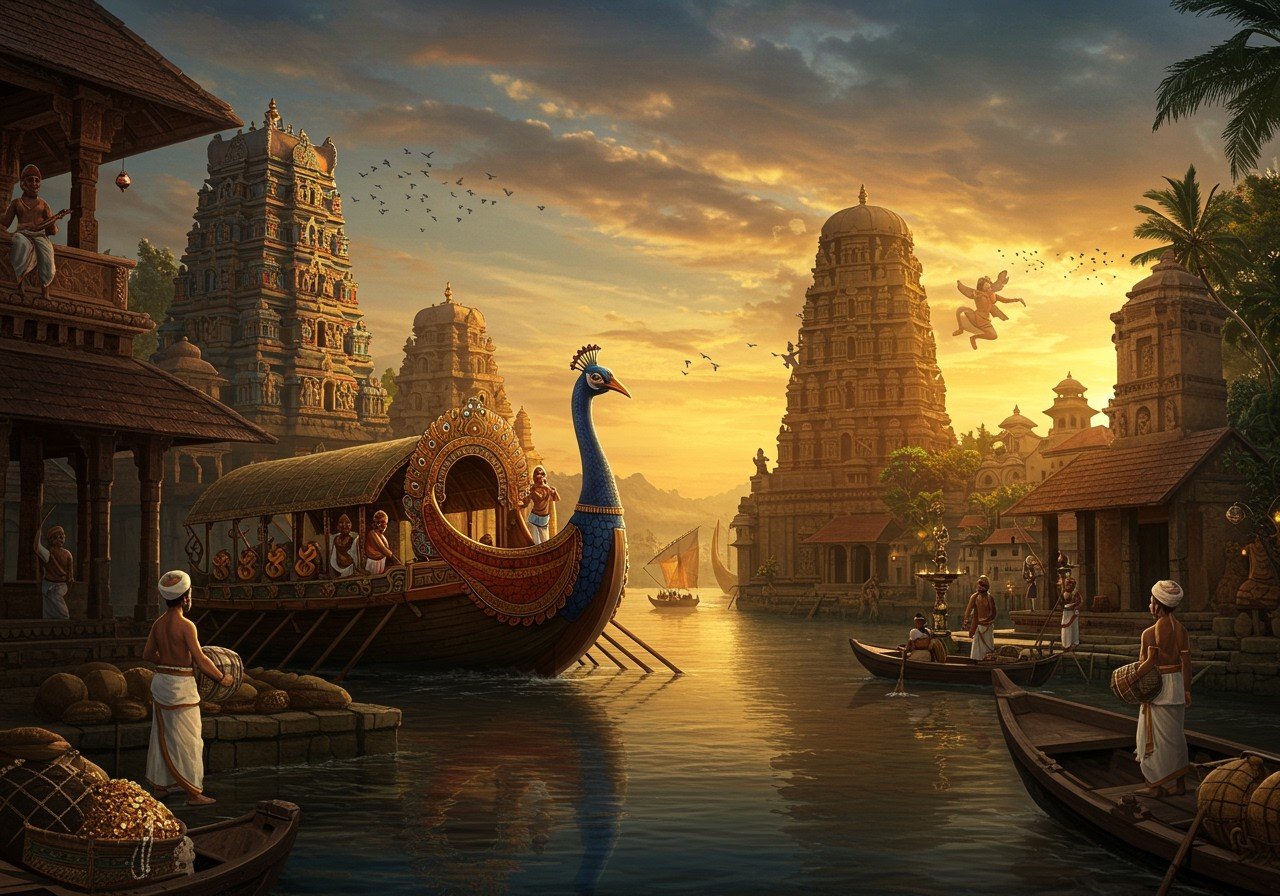
The Chera Dynasty, also known as Keralaputra, holds a prominent place in the history of South India. This ancient Tamil dynasty, one of the Three Crowned Kings of Tamilakam alongside the Chola and Pandya dynasties, ruled parts of present-day Kerala and Tamil Nadu during the Sangam period. Their influence on art, architecture, and traditions continues to resonate in modern culture. Uthiyan Cheralathan stands as the earliest recognized Chera ruler.
Chera Dynasty Art and Architecture
The Chera Dynasty is renowned for its distinctive art and architectural styles, deeply influenced by the cultural and religious landscape of their time.
- Intricate Carvings and Sculptures: Chera temples and palaces showcase the exceptional artistry of their artisans through detailed carvings and sculptures, often depicting mythological narratives and religious themes. These intricate works reflect the dynasty’s deep connection to spirituality and storytelling.
- Architectural Features: Constructed primarily from granite, Chera temples boast elaborate gopurams (temple towers), a hallmark of Dravidian architecture. This choice of material ensured the structures’ durability and grandeur, standing as testaments to the dynasty’s power and architectural prowess. The Aihole Durga Temple and the Badami Cave Temples offer further insights into similar architectural styles.
- Murals and Frescoes: Adding to the visual richness of Chera temples are murals and frescoes that portray mythological stories and religious themes. These vibrant depictions served to educate and inspire devotees, offering glimpses into the rich tapestry of beliefs and narratives prevalent during the Chera period.
- Stone Inscriptions: Stone inscriptions found within Chera architecture serve as invaluable historical records, offering insights into the dynasty’s achievements, significant events, and the evolution of Tamil script. These inscriptions provide a window into the past, allowing us to connect with the Chera Dynasty on a deeper level.
- Patronage of the Arts: Kings and nobles of the Chera Dynasty generously supported temple construction and artistic endeavors, leading to the flourishing of Chera art and architecture. This royal patronage ensured that skilled artisans and craftsmen had the resources to create magnificent works that continue to inspire awe and admiration.
- Trade and Cultural Exchanges: Trade with neighboring regions facilitated cultural exchanges, introducing foreign influences that enriched and diversified Chera art. This intermingling of cultures created a unique artistic blend that reflects the dynasty’s openness to new ideas and artistic styles.
Chera Dynasty Emblem
The emblem of the Chera Dynasty, the ‘Bow and Arrow,’ symbolizes the martial prowess and valor of its rulers.
- Historical Significance: The bow and arrow emblem is frequently represented in various artifacts and inscriptions, signifying the Chera Dynasty’s military strength and the importance of archery in their culture.
- Official Use: Appearing on seals, coins, and banners, the emblem served as a mark of authority and legitimacy for the Chera rulers. Its presence on official items signified the dynasty’s power and reign.
- Symbolic Meaning: In Indian culture, the bow and arrow represent strength, precision, and protection, qualities highly valued by the warrior kings of the Chera Dynasty.
Chera Dynasty Language and Literature
The Chera Dynasty significantly impacted Tamil literature, fostering a rich literary tradition through their patronage of the Tamil Sangam.
- Tamil Sangam: The Cheras’ support of the Tamil Sangam, an assembly of Tamil scholars and poets, led to the creation of a significant body of classical Tamil literature. Works like Pattupattu (Ten Idylls) and Ettuthokai (Eight Anthologies) are testaments to this flourishing literary period.
- Linguistic Influence: Tamil inscriptions from the Chera period offer valuable insights into the evolution of the Tamil language and its various dialects. These records serve as important resources for understanding the development of one of South India’s prominent languages.
Chera Dynasty Religion
The Cheras were devout worshippers of Shiva and constructed numerous temples, showcasing their religious fervor and architectural prowess.
- Religious Patronage: The Chera kings actively supported the construction of temples and the development of religious institutions. This patronage played a vital role in shaping the religious landscape of the region.
- Integration of Traditions: The Chera period witnessed the integration of local folk traditions into mainstream religious practices, creating a vibrant and diverse religious tapestry. This blending of traditions reflects the dynasty’s inclusive approach to spirituality.
Chera Dynasty: A Cultural Legacy
The Chera Dynasty’s legacy extends beyond its political reign. Their contributions to art, architecture, literature, and religion have left an indelible mark on South Indian culture. The bow and arrow, their enduring emblem, serves as a reminder of their strength and influence. By exploring their history, we gain a deeper appreciation for the rich tapestry of South India’s cultural heritage.
For those seeking to connect with the spiritual traditions of the Chera era and beyond, Poojn.in offers a wide array of sacred items and puja essentials. Discover authentic products that honor these ancient practices by visiting Poojn.in today. Explore our collection of Ashoka Chal Powder, Arjun Chal Powder, and other sacred herbs used in traditional rituals.


